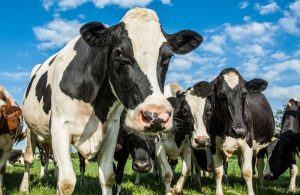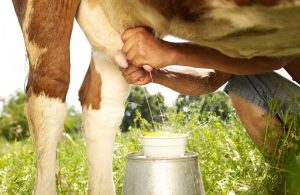
What You Need to Know About Cows Producing Milk
If you purchase milk from the grocery store, you may rarely think about what goes into the process of getting the milk from the cow. One of the most popular reasons to own cows is so that you can have your own supply of milk. Many homesteaders rather raise their own cows to produce organic milk rather than purchase milk from the store that has been filled with chemicals and preservatives.
How often do cows produce milk? A cow will only produce milk after having a baby, with the ability to be milked every day as long as the calf keeps suckling or the cow keeps getting milked. About 60 days after giving birth, the calf becomes more reliant on other food sources and the cow’s milk production will start to gradually decline until the cow is producing very little milk.
Having milk cows can save you hundreds of dollars a year on milk. It’s also a great way to ensure the milk you’re drinking is organic and free of harmful preservatives. To learn more about cows producing milk, keep reading!
How Much Milk Do Cows Produce?
The breed of the cow will usually determine the amount of milk the cow produces each day during its lactation period. For common milking breeds like Jersey cows and Holstein cows, over 7-10 gallons can be produced per day, per cow . Cow breeds more popularly used for beef, like Angus cows or Hereford cows, tend to produce less milk, averaging about 1 gallon of milk per day.
That’s a lot of milk! With just one cow, you could have enough milk to supply your friends and family with a gallon each week. This is something you should keep in mind if you plan on harvesting and preparing the milk yourself. If you’re a homesteader simply looking for a way to be self-sufficient in finding food and nutrients, you may be in for a big surprise when you start finding yourself getting gallons of milk a day.
Can Milk Cows Continue to Be Nursed by Calves?
 Cows can easily generate enough milk to feed their calves as well as provide you with a few gallons each day. Suckling calves can drink up to 3 gallons of milk a day, as they depend on their mother’s milk for most of their nutrients. Calves will be most dependant on their mother’s milk as newborns. As they age, grass and hay will be incorporated into the diet and the calf will rely less on the milk. A calf can usually be completely reliant on forage around 3 months old, where they will no longer need milk.
Cows can easily generate enough milk to feed their calves as well as provide you with a few gallons each day. Suckling calves can drink up to 3 gallons of milk a day, as they depend on their mother’s milk for most of their nutrients. Calves will be most dependant on their mother’s milk as newborns. As they age, grass and hay will be incorporated into the diet and the calf will rely less on the milk. A calf can usually be completely reliant on forage around 3 months old, where they will no longer need milk.
If you want your cow to keep producing milk even after their calf is weaned, you will need to continue to milk them on a daily basis. From the time the calf is weaned, the mother’s milk production will gradually diminish until the cow can no longer produce milk, which is usually around 7 – 10 months.
If you want your cow to continue to produce a good amount of milk even after its calf is 3 months old, you can increase the number of times you milk the cow per day. You can also continue to let the calf nurse, which will naturally mean the cow has to produce more milk. If given the opportunity, many calves will continue to nurse even when they are completely reliant on grass and hay.
How to Pasteurize Cow Milk:
One of the reasons many people want cows is so they’ll have their own supply of milk. When it comes to drinking milk from your cow, you’ll want to pasteurize the milk beforehand. Pasteurization is when you heat the milk to kill any pathogens or microorganisms that could be harmful for consumption. Pasteurizing cow milk on your own is a straightforward process with only a few steps. Here’s how to pasteurize cow milk:
- Put the raw milk in a pot on the stove. Ideally, you should use a double boiler to avoid scalding the milk, but it can be done without one.
- Stir the milk occasionally as you start to increase the temperature. Stirring can keep the milk from scalding.
- Once the temperature of the milk reaches 145°F (63°C), you’ll leave the milk at that temperature for 30 minutes.
- After 30 minutes of boiling the milk at 145°F, remove the pot of milk from the stove and place it in a larger pot filled with ice.
- Leave the pot of milk in the ice until the milk cools to 40°F (4°C). From there, you can pour the milk into containers and store it in a refrigerator.
Remember, if you’re bringing home a few gallons of milk a day from your cows, you could spend a lot of time in the pasteurization process. Drinking raw milk can lead to food poisoning-like symptoms, like nausea, headaches, vomiting, and diarrhea. It can also lead to dangerous bacterial infections like Salmonella and E.Coli.
How Often Should You Milk a Cow?
Milking a family cow can be different than milking a cow used in commercial milk production. Family milk cows are usually milked twice a day, once in the morning and once in the evening. This system keeps the cow from drying up and keeps its udder happy. In commercial milk production, the cow may be milked three or four times a day to get the biggest return. More frequent milking times, like in the commercial world, can keep the cow at the highest milk production.
Another option is to milk your cow once a day. This is a newer trend that is still being investigated and researched to learn all the benefits and downfalls. Milking once a day can work if your cow is also nursing a calf. This way, you’re able to get your milk supply while there is still enough milk left over for the baby. This routine can also make the cow produce less milk compared to if it’s being milked a few times every day.
What Happens If You Don’t Milk a Cow?
Milking your cow on a regular basis is important to the general overall health of the cow. If you skip a milking session or a calf isn’t feeding, the udder of the cow can become full and tender, causing the cow great discomfort. Furthermore, this can also lead to bacterial infections in the teats known as mastitis.
Mastitis is commonly recognized when a cow’s teat swells up considerably due to bacteria in the teat canal. Mastitis is usually treated using antibiotics; however, severe cases could result in the cow being culled. These are big repercussions to what seems like a simple thing such as skipping a milking. However, it’s important to realize that you’re not just milking a cow to have a supply of milk but also to take care of the well-being of your livestock.
When Does a Cow’s Milk Dry Up?
A cow will continue to produce milk until her calf is weaned. Calves are usually weaned anywhere from 3-6 months; however, if left with their mothers, calves may continue to nurse as long as you let them. When a calf is weaned from its mother, the mother will continue to produce milk for 2-5 more weeks before its milk dries up naturally. In the meantime, you’ll have to continue to milk the cow to avoid build-up and bacterial infections in the udder.
If you want to keep your cow’s milk from drying up, the best thing to do is milk the cow more frequently. This, in turn, will lead to the cow producing more milk. While the cow will eventually dry up at some point, it’s common for milk cows to still be able to produce a good amount of milk even 10 months after giving birth when milked frequently.
Can Milking a Cow Be Unhealthy?
While regular milkings can keep your cow’s udder from getting to full and can keep bacterial infections from setting in, there is a time when a cow should not be milked, and that is for the last few months of their pregnancies. Cows can be pregnant and continue to be producing milk from their last calf.
In fact, commercial milk producers will usually breed their milk cattle once a year to ensure the cows are being milked for at least 10 months out of the year. The other two months of the year, the time leading up to giving birth, is designated as a “dry season” for the cattle to ensure the cow is more healthy at birth and can produce milk for the new calf.
In this time frame, the cow should be dried up, meaning that the owner of the cow will need to assist in helping the cow stop producing milk. This is done by feeding lower quality food and milking less. The cows will need to be checked on frequently to ensure there are no symptoms of mastitis.
Did you find this article helpful? We have many others on different livestock care! Check out the articles below:
